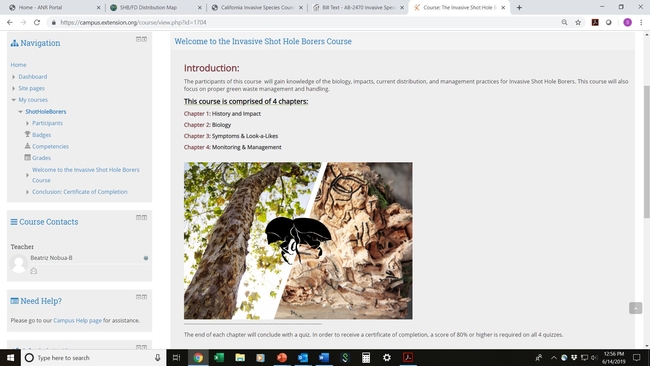
Posts Tagged: ambrosia
Laurel Wilt Disease Update
Laurel Wilt-Ambrosia Beetle Grower's and Advisory Panel meeting to update and discuss research and extension programs supported by the USDA research grant.
Purpose: The Univ. of Florida/IFAS created a panel consisting of local commercial avocado growers and handlers and scientists for the USDA grant on laurel wilt and ambrosia beetles. The purpose of the meeting is for researchers to update avocado growers and the advisory panel on the progress of research on this grant and to discuss future research and extension plans. This meeting is open to anyone to attend.
Date: July 23, 2020
Time: 10AM-12PM
Location: ZOOM, recording available HERE
AGENDA
Dr. Crane, welcome and introduction
Brief updates, plans and discussion:
1. Dr. Schaffer, Environmental Plant Physiology – Laurel wilt susceptibility of avocado scions and rootstocks in relation to physiology and stem anatomy
2. Dr. Gazis, Plant Pathology – Laurel Wilt - Plant Pathology: Research Accomplishments, Current Work, and Future Direction
3. Dr. Carrillo, Entomology – Update laurel wilt ambrosia beetle research
4. Dr. Evans and Mr. Ballen, Ag Economics - current work and work in progress and plans
5. Dr. Crane and Mr. Wasielewski – Current extension program and plans
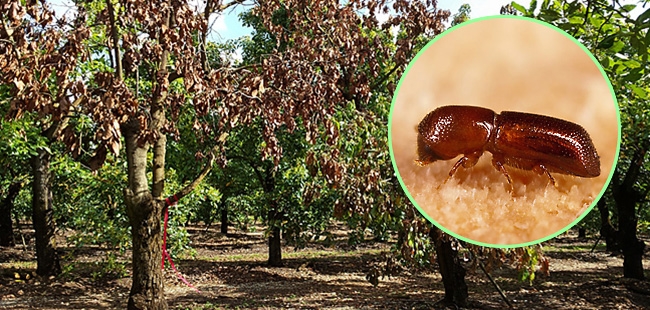
laurel-wilt-and-avocado-trees
New Recommendations for Laurel Wilt Disease
Laurel Wilt Disease of Avocado and the relatives of avocado in the Laurel Family has devastated the the forests along the east coast from North Carolina down to Florida and along the Caribbean into Texas. It has caused significant losses to wildlands and to the Florida avocado industry.
The extent of the native tree loss is shocking and there is very little that can be done to correct the problem, other than to curb the spread of contaminated wood that is spread by humans, There has been some success in the avocado orchards. While there is no "silver bullet", there is some progress, e.g. pruning to increase light levels to suppress Ambrosia Beetle activity. In addition, research has continued for:
- Vaccinations to protect avocado trees from the LW pathogen
- Developing a faster LW diagnostic tool
- Screening scions and rootstocks for tolerance/resistance
- AB control tactics and suppression
- Molecular understanding of the pathogen
- Economics and the LW epidemic
Read the latest results in these two recent publications:
Photo: Dead avocado trees from Laurel Wilt in Florida
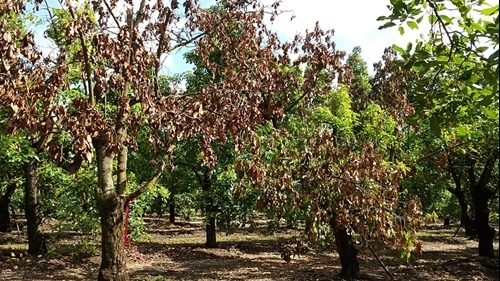
laurel wilt trees
Alcohol Loving Ambrosia Beetles
Ambrosia beetles, which are a large group of several thousand species worldwide, belong to the bark beetles. All species are characterized by the ability to cultivate fungi. Invasive Shot Hole Borers that attack avocado and a range of native and landscape trees in California and the Laurel Wilt Disease that hammers avocado in Florida are ambrosia beetles. These beetles cultivate fungi in living trees and over time, the fungus is what kills the tree.
Beetles share the work of cultivating their fungal gardens: some clean the tunnel systems that are being eaten into the wood; others clear the dirt from the nest and clean their fellow workers -- always with the aim of optimizing the symbiosis of beetle and fungus.
It's been long known that alcohol is produced by weakened trees and that these trees are recognized and colonized by the beetles. Traps baited with alcohol are used to catch the insects when they fly. Alcohol is very attractive to the beetles in large part because the fungi they feed on performs best in an alcohol-rich environment. Alcohol is normally used as a preservative to impede other fungi, such as molds from growing, and this is the case for the fungi associated with these beetles. They prefer to grow in an environment where other fungi don't grow.
Here's an interesting article showing how this preference by disease-causing fungi allows them to thrive in a normally harsh environment. Maybe it can be exploited.
Christopher M. Ranger el al., "Symbiont selection via alcohol benefits fungus farming by ambrosia beetles," PNAS (2018). www.pnas.org/cgi/doi/10.1073/pnas.1716852115
Photo: Party Beetles
Credit: Gernot Kunz
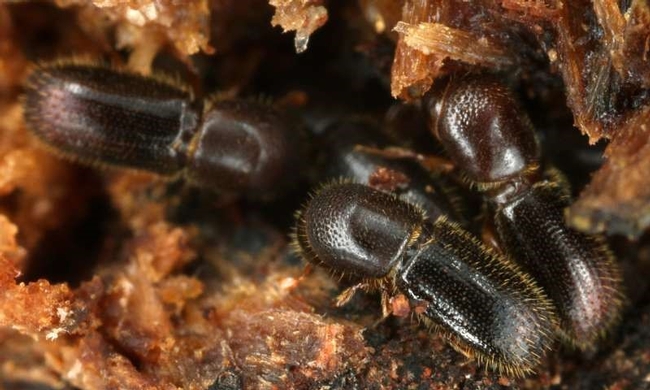
ambrosia beetles
ISHB Update and an Online Training Course
Update on invasive shot hole borers: Online training now available
By Sabrina Drill, Natural Resources Advisor, UCCE Ventura
Invasive shot hole borers (ISHB) are a pest and disease complex potentially affecting over 200 tree species, but posing a strong risk to box elders, sycamores, and other riparian and urban trees, as well as being a nuisance pest for avocado. The beetles have also been shown to attack a wide variety of common and less common ornamental species. For a complete host list, visit https://ucanr.edu/sites/pshb/overview/SHB_Reproductive_Hosts/. The tiny beetles burrow into the trunks and branches of trees and create galleries where they cultivate a fungus that utilizes the trees own circulatory system, harming and in some cases killing the tree. We know the beetle can reproduce in over 60 species of trees, and they have devasted natural riparian areas, though we are beginning to see recovery of some infestations. Currently, the most effective management method is to remove infested wood, sometimes entire trees, and chip what is removed to minus 1”.
ISHB are now firmly established in Ventura County, with finds throughout the Santa Clara River Valley in traps from South Mountain to Toland Park in Santa Paula, and several infested box elder and sycamores in Meiner's Oaks and Ojai. It appears not to have crossed into the county in the south, but there are still active infestations in western Los Angeles County.
Personnel from UC ANR, CDFA, the Ventura County Agricultural Commissioner, and the US Forest Service have taken lead roles in developing a statewide ISHB action plan for the California Invasive Species Advisory Committee, with an initial investment of $5 million to work on controlling the pest. Plan elements include research in the ecology and control of the pest, including work to develop biocontrol; an early detection and surveillance program; addressing green waste and other pathways of spread, and outreach and education.
In terms of education and outreach, an area where Cooperative Extension in Ventura, LA, Orange, and San Diego counties have led, we're excited to announce the release of a new on-line training course. Available through our website, https://ucanr.edu/sites/pshb/, the course is actually served by the eXtension on-line learning platform (and users will need to create a free account). The course consists of 4 chapters including history and impacts, biology, symptoms and look-alike pests, and monitoring and management. While it can't fully replace a field training, it can be a good way to familiarize new staff to the issues.
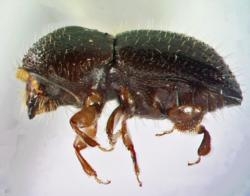
shot hole borer
Talking Avocado Laurel Wilt
“Laurel wilt – A threat to California's avocado industry”
Presented by: California Avocado Society, Inc., California Avocado Commission, University of California Cooperative Extension, and University of Florida's Tropical Research and Education Center. Event is FREE, everyone is welcome!
- Tuesday, July 30, 2019, 9-11 AM.,
Pala Mesa Resort, Fallbrook
- Wednesday, July 31, 2019, 9:00 a.m. to 11:00 a.m.,
UC Cooperative Extension Office Auditorium, 669 County Square Dr. Ventura, CA 93003
- Thursday, August 1, 2019, 9-11 AM.,
San Luis Obispo Farm Bureau Office
Agenda
The current status of Laurel Wilt in South Florida
Laurel Wilt epidemiology and management
Laurel Wilt Vectors and Management
Vascular physiology, anatomy and susceptibility of different avocado cultivars
Economic impact of control strategies
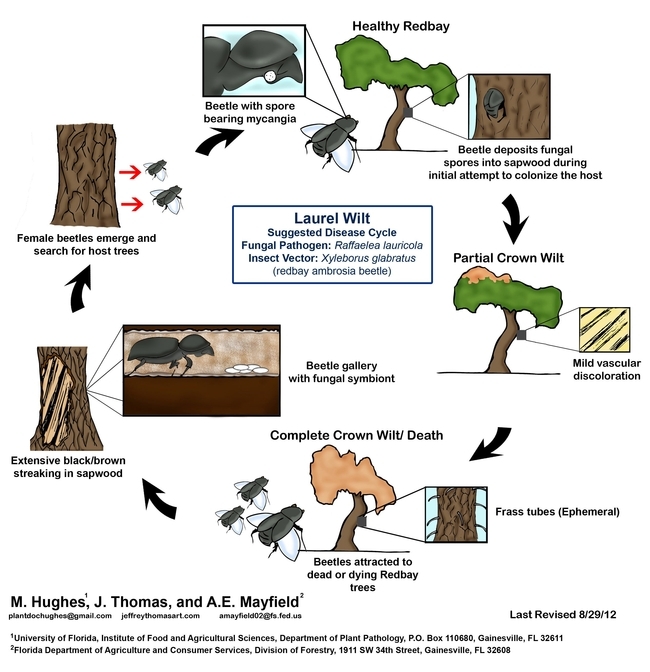
laurel wilt cycle
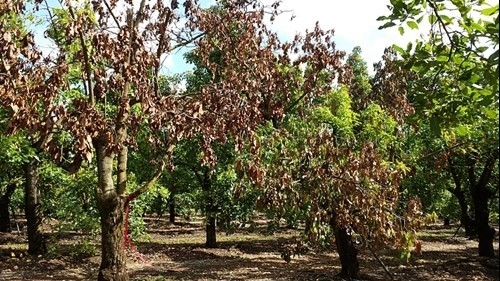
laurel wilt trees

